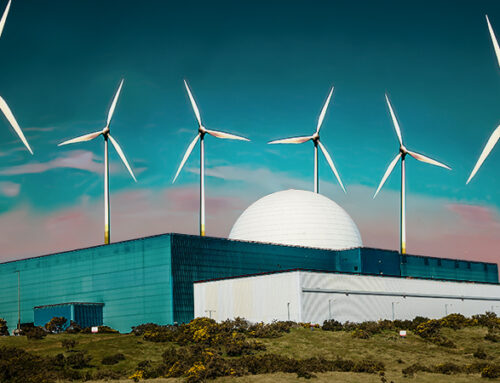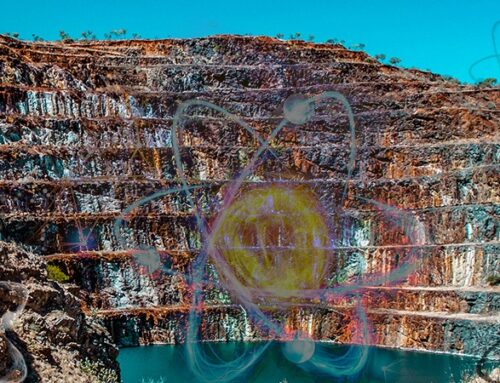Following my previous two posts here and here on the nuclear fuel supply chain, in this post I will look at the geopolitical concerns relating to Russia’s dominance of certain parts of the supply of nuclear materials to civil generation programmes.
Despite being concentrated, the market for natural uranium is not under threat
The war in Ukraine, has exposed the European and global dependence on Russian nuclear fuel production. Russia is among the five countries with the world’s largest uranium resources. It is estimated to have about 486,000 tons of uranium, the equivalent of 8 percent of global supply. However actual raw uranium production is relatively low at just 5% of extraction in 2021.
Currently Kazakhstan has the largest market share of natural uranium mining, which implies larger market strength than it actually has since there are very large uranium deposits elsewhere. Australia has proven reserves of some 1.7 million tonnes compared with the annual global demand for uranium of 65 thousand tonnes – any action by Kazakhstan to restrict supply would simply incentivise the development of new mines in Australia and Canada which also has significant reserves, leading to a permanent reduction in Kazakhstan’s market share.
This is acting as a strong dis-incentive to disruptive behaviour. In addition, the UK has 110,000 tonnes of uranium stockpiles from past reprocessing, against a requirement of just over 800 tonnes per year for the current fleet. While the quality of the stockpile varies, it is large enough to cover the UK’s primary uranium needs for many years. France is also thought to have uranium stockpiles.
The midstream conversion and enrichment process are more dependent on Russia
The primary geopolitical concerns around the uranium supply chain are not in the upstream segment but the midstream, specifically conversion and enrichment, and this is where Russia has secured a dominant position. Russia currently owns around 20% of global uranium conversion capacity and 40% of enrichment capacity, but it is active across the nuclear fuel cycle and is arguably the world’s dominant player in the sector. In 2020 almost 40% of converted uranium came from Russia.
“Rosatom is one of the few companies in the world that has mastered the entire nuclear fuel cycle, i.e. enrichment, fuel production and also reprocessing,”
– Sonja Schmid, professor of science and technology studies at Virginia Tech and the author of “Producing Power: The Pre-Chernobyl History of the Soviet Nuclear Industry
In 2020 Russia also supplied 46% of enriched uranium, although its market share is expected to fall with an increase in Chinese capacity, which is hardly comforting for western buyers. The EU procured about 20% of its natural uranium and 26% of its enrichment services from Russia in 2020, while the US imported about 14% of its uranium and 28% of all enrichment services from Russia in 2021.
Concerns over Russian dominance have come just as interest in nuclear power has begun to grow after years of neglect. At the COP28 climate conference in Dubai, more than 20 countries, led by the US, pledged to triple global nuclear power capacity by 2050. There were calls for “…promoting resilient supply chains, including of fuel, for safe and secure technologies used by nuclear power plants over their full life cycles.”
Central and Eastern European countries are particularly reliant on Russian fuel. There are a total of 18 Russian-designed nuclear reactors — in Slovakia, Bulgaria, Hungary, the Czech Republic and Finland — that currently run exclusively on Russian fuel and rely on Russian technologies. Additionally, Rosatom has had a long association with French utility EDF with the two signing a “long-term cooperation agreement” in 2021 to further boost ties. However, led by Ukraine, many of these countries are moving to Westinghouse fuel for their reactors, to reduce reliance on Russia.
Elsewhere, several countries are deepening their reliance on Russian nuclear supplies – China, India, Turkey, Bangladesh and Egypt are all building new Russian water-water energetic reactors (“VVERs”). These projects are likely to continue given a lack of alternative suppliers for the technology and a lack of strong condemnation of Russia’s war in Ukraine among these nations.
Western countries import significant amounts of Russian nuclear material
France imported €359 million worth of enriched uranium from Russia in 2022, up from €92.4 million in 2021. However, the lower figure in 2021 may be due to the fact that in previous years, some French purchases of Russian enriched uranium were delivered directly to fabrication facilities abroad. The US imported US$ 829.8 million worth of Russian materials in 2022 compared with US$ 645.5 million in 2021. This likely consisted primarily of enriched uranium.
South Korea imported US$ 184.4 million worth of Russian nuclear products in 2022, down from US$ 251.7 million the previous year, while China bought US$ 492.6 million worth of Russian nuclear goods in 2022. There have been suggestions that if Russian uranium supplies are sanctioned in the west, China could increase exports of its own enriched uranium to western countries, which uses Russian feedstocks. There is some evidence this is now happening, and that France is also acting as a conduit for Russian nuclear products due to gaps in the sanctions regimes.
In May 2024 the US banned imports of Russian uranium. The 2024 US National Defense Authorization Act, directed the Department of Energy to promote production of low-enriched uranium in the US for existing reactors and pushes for faster development of US HALEU production for advanced nuclear reactors. There is bipartisan support for the Accelerating Deployment of Versatile, Advanced Nuclear for Clean Energy (ADVANCE) Act, which would accelerate development of advanced reactor technologies.
Europe is also concerned about its dependence on Russia. The EU actually increased purchases of Russian uranium in 2023, partly as a result of stockpiling in anticipation of future supply disruptions either from sanctions or other supply restrictions. These concerns are leading Europeans to develop plans to expand their midstream uranium processing capacity, however, while enrichment is a high value, high margin activity, creating incentives for western organisations such as Urenco and Orano to develop new capacity to erode Russia’s market share, the greater problem lies with the lower margin conversion process which is far less attractive to private investors. Orano has plans to scale up its capabilities, as does Converdyn in US, but there is still a supply gap.
The only country that with mothballed conversion capacity that could be brought back to service is the UK (the Westinghouse Springfields facility). Re-opening and/or re-developing this was in the civil nuclear roadmap, but it remains to be seen whether it will be a priority for the new Labour Government. Labour’s claims to want to reduce reliance on imported energy would tend to support the plans, but it’s too early to say how this policy will manifest, particularly in light of the contradictory announcements on halting North Sea licensing.
In addition, the market for uranium conversion is volatile – current prices are US$ 38 /tonne compared with US$ 7 /tonne just a few years ago. Without government support it’s unclear whether the private sector would be willing to take on these risks. In general the bigger market participants have addressed this through vertical integration, although that is not appealing to everyone, with Urenco being a particular example which is focusing on increasing capacity in the parts of the value chain in which it already operates, rather than seeking to acquire the whole mid-stream segment.
On the flip side, the market generally operates on the basis of long-term contracts. Utilities which operate nuclear reactors tend to buy mining, conversion, enrichment and fabrication services themselves, or have enrichers provide everything from mining through to enriched uranium. It’s less common for different elements of the supply chain to operate on a merchant basis, buying feedstocks and selling product independently of a wider contracting arrangement driven by a utility.
Although utilities may try to include some competitive tension by procuring from more than one vendor, for example Energoatom in Ukraine might buy mining and conversion services from Cameco in Canada, and instruct Cameco to ship its uranium hexafluoride to Urenco for enrichment, and then instruct Urenco to send the enriched uranium to Westinghouse in Sweden, for fabrication into fuel rods. However, fuel is a relatively small part of the overall cost of nuclear power, so this effect is limited. The final stage of fuel fabrication is different in that the fuel for a particular reactor is generally tied to the reactor vendor.
Reprocessing may provide a solution to some supply chain constraints
Another option is to turn to reprocessing of spent nuclear fuel as a source of new fuel. Spent fuel contains large amounts of fissile material which can be recycled for further use. Currently about 17% of the nuclear fuel used in the French pressurised water reactors is derived from recycled fuel. Conventionally, only the plutonium recovered from processed fuel has currently used in mixed-oxide (“MOX”) fuel in France. However, reprocessed uranium – or RepU – can be re-enriched for use as fuel in existing light-water reactors. Four French reactors at the Cruas-Meysse plant in Auvergne-Rhône-Alpes are certified to use such uranium. In February 2024, Cruas 2 became the first of those units to operate with a full core of fuel made from recycled uranium, with fuel reprocessed at the Orano plant at The Hague.
“Reprocessing spent fuel to extract the energy-potential material (which constitutes 96% of the spent fuel’s mass composition), namely uranium, for its second use is a circular economy approach that will save 25% of natural resources in the coming decades. Moreover, this sector emits 30% less CO2 than the natural uranium sector and reduces environmental impact,”
– Cédric Lewandowski, Senior Executive Vice-President, Nuclear and Thermal at EDF
Fuel containing RepU has the same general characteristics as natural uranium fuels, and has been, or is currently used in 75 reactors worldwide. EDF plans to use RepU in some of its 1300 MW reactors by 2027, aiming for over 30% RepU usage in the French fleet by the 2030s.
While reprocessed fuel must be re-enriched, it does not need to pass through the conversion process, by-passing a part of the supply chain which is economically difficult. Since all nuclear operators must eventually deal with the waste they produce, there may be some benefits both in terms of overall economics and security of supply from developing reprocessing capabilities. It is also likely that advanced nuclear technologies will be able to run on recycled fuels, and several countries are considering reprocessing plans for this purpose.
Might fast-breeder reactors see a renaissance
A further, less likely option in the near term, is to revive fast breeder reactors (“FBR”). Several western countries discontinued FBR programmes with France holding on for the longest before finally shutting its Superphénix reactor in 1998, in what French Parliamentarians described in a 2023 report as the “original sin” of anti-nuclear ideology that has harmed the French nuclear power sector.
Breeder or breeding reactions are reactions in which more fissile fuel is produced than consumed. In a regular U-235 fission reaction, a neutron is absorbed by a U-235 atom to create U-236, an extremely unstable isotope of uranium, which then splits into multiple smaller atoms, producing a variety of smaller elements and releasing two or three neutrons. These neutrons are then free to combine with other U-235 atoms, initiating further fission reactions in a self-sustaining chain reaction. This process produces large amounts of nuclear waste since less than only about 3-5% of the fuel contains fissile U-235 so finding a way to utilise the remaining 95-97% (U238) could increase the efficiency of the reactor’s fuel consumption.
Neutrons produced in conventional fission reactions have high energies and move very fast. However, they do not cause fission reactions as efficiently as slower-moving neutrons, so they are typically slowed by the process of moderation – a liquid or gas moderator, generally water or helium, cools the neutrons to optimum energies for causing fission.
In a fast breeder reactor, the coolant used is not an efficient moderator, allowing its neutrons retain high-energy. Although these fast neutrons are not as good at causing fission, they are readily captured by U-238 which then becomes plutonium (Pu-239). This plutonium isotope can be reprocessed and used as more reactor fuel. Reactors can be designed to maximise plutonium production, and in some cases they produce more fuel than they consume, making them “breeder” reactors. Because these reactions use the more abundant U-238 than the normally fissile U-235, they allow a much more efficient use of natural uranium and would reduce or even eliminate the need for enrichment.
Unfortunately the moderators used in FBRs – often sodium-based – are highly corrosive, creating materials integrity problems. All of the FBR programmes in the west closed due to concerns over costs and operational problems, although Superphénix (and to a lesser extent, the UK’s experimental Doureay programme) were arguably closed at the point where most of the operational challenges had been overcome. They were not given the opportunity to demonstrate this, so these arguments are speculative, although the successful performance of Russian FBRs suggest it might be the case.
A key attraction of FBRs had been their plutonium production which could also be used in military applications, but by the 1990s, governments had more than enough plutonium for all the bombs they could ever want, and the adverse economics of FBRs and relative low cast of nuclear fuel meant the operational problems were not considered worth solving. Although FNR development effectively ended in Europe and the US by the 1990s, it continued in Russia, China and India, where there are now five FNRs in operation and five more under development.
Russia’s BN reactors have already proved the commercial viability of sodium-cooled FNRs, while its lead-cooled Brest reactor and associated ODEK project are on track to demonstrate the feasibility of a completely closed fuel cycle based on FNRs in which specially developed fuel can be recycled and wastes reprocessed at a single site.
India is also developing a 500 MW prototype sodium-cooled fast breeder reactor at Kalpakkam, which is currently under construction and is expected to open this year. However, the project has experienced delays and cost over-runs, but despite these and historic challenges with fast breeder reactors, India is persevering, in part due to increasing difficulties in obtaining uranium due to the effects of international sanctions.
Concerns over access to conventional nuclear fuel might prompt renewed interest in FBRs in the west. France has entered into a partnership to develop advanced nuclear technologies including FBRs. The Generation IV International Forum, whose members include the UK, France, Euratom, the US and others also has FBRs as part of its development programme. Work on molten salt reactors is also likely to cross over into FBRs around the use of sodium-based cooling systems.
.
There is no question that the world is seeing a huge renewal in interest in nuclear power. The lives of existing reactors are being extended, new reactors are being built and new reactor technologies are being developed, although some – notably Germany and Spain – are swimming against the tide. At the same time, it is recognised that Russia has acquired a dominant position in the midstream segment of the fuel supply chain, causing some anxiety for western operators.
In the short term, the response to this appears to have been to build stockpiles even if this means exploiting loopholes in sanctions, and to develop, re-develop or expand conversion and enrichment capabilities to cut Russia out of these supply chains going forward. Longer-term, the renewed focus on energy security is likely to mean that countries see energy supplies as being of greater strategic importance, and will develop their nuclear programmes with robust supply chains.






Good to see that GWPF finally got around to publishing your report on interconnectors.